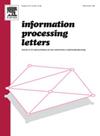分辨率大小和高度之间的简单超临界权衡
IF 0.6
4区 计算机科学
Q4 COMPUTER SCIENCE, INFORMATION SYSTEMS
引用次数: 0
摘要
我们用n个变量来描述cnf,在一个参数范围内,具有小的分辨率反驳,但任何小的反驳必须具有大于n的高度(甚至是n的指数),其中反驳的高度是其中最长路径的长度。这被称为大小和高度之间的超临界权衡,因为如果我们不关心大小,每个CNF在高度n上都是可反驳的。我们的证明方法使用一个简单的结构,基于整数的或化和基于d的表示,来减少变量的数量。类似的结果出现在[Fleming, Pitassi和Robere, ITCS '22]中,不同的公式使用更复杂的结构来减少变量的数量。我们的公式的微小反驳必然是高度不规则的,这使得将解析从池解析中分离出来成为一个合理的候选,这相当于将有重启的CDCL从没有重启的CDCL中分离出来。我们无法证明这一点。在另一个方向上,我们展示了我们的公式的一个更简单的版本,具有类似的不规则性,确实有多项式大小的池分辨率反驳,因此没有为CDCL提供这样的分离。本文章由计算机程序翻译,如有差异,请以英文原文为准。
A simple supercritical tradeoff between size and height in resolution
We describe CNFs in n variables which, over a range of parameters, have small resolution refutations but are such that any small refutation must have height larger than n (even exponential in n), where the height of a refutation is the length of the longest path in it. This is called a supercritical tradeoff between size and height because, if we do not care about size, every CNF is refutable in height n. Our proof method uses a simple construction, based on or-ification and base d representations of integers, to reduce the number of variables. A similar result appeared in [Fleming, Pitassi and Robere, ITCS '22], for different formulas using a more complicated construction for reducing the number of variables.
Small refutations of our formula are necessarily highly irregular, making it a plausible candidate to separate resolution from pool resolution, which amounts to separating CDCL with restarts from CDCL without restarts. We are not able to show this. In the other direction, we show that a simpler version of our formula, with a similar irregularity property, does have polynomial size pool resolution refutations and thus does not provide such a separation for CDCL.
求助全文
通过发布文献求助,成功后即可免费获取论文全文。
去求助
来源期刊

Information Processing Letters
工程技术-计算机:信息系统
CiteScore
1.80
自引率
0.00%
发文量
70
审稿时长
7.3 months
期刊介绍:
Information Processing Letters invites submission of original research articles that focus on fundamental aspects of information processing and computing. This naturally includes work in the broadly understood field of theoretical computer science; although papers in all areas of scientific inquiry will be given consideration, provided that they describe research contributions credibly motivated by applications to computing and involve rigorous methodology. High quality experimental papers that address topics of sufficiently broad interest may also be considered.
Since its inception in 1971, Information Processing Letters has served as a forum for timely dissemination of short, concise and focused research contributions. Continuing with this tradition, and to expedite the reviewing process, manuscripts are generally limited in length to nine pages when they appear in print.
 求助内容:
求助内容: 应助结果提醒方式:
应助结果提醒方式:


